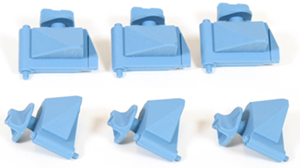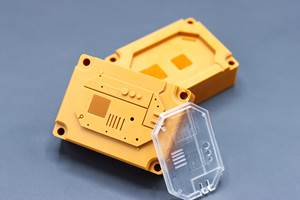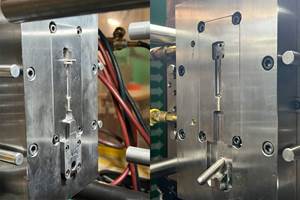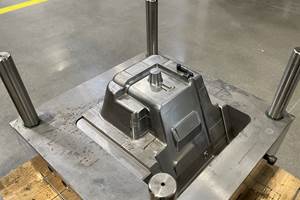New Class of Photoplastics for SLA 3D Printing of Durable Prototypes, Tooling, Functional End-Use Parts
Nexa3D and Henkel have announced availability of three functional photopolymers with extended UV weathering stability.
The availability of three new functional polymers, said to represent a new class of photoplastics and designed for durable prototype, production tools and functional end-use parts with extended UV weathering stability have been announced by Nexa3D, Ventura, Calif., the maker of ultra-fast SLA production 3D printers and Germany’s Henkel. Available through Nexa3D’s globally expanding channels, the three new performance photopolymers represent the company’s further collaboration with Henkel which leverages their combined capabilities to fast-track additive manufacturing towards mass production of functional parts across multiple industries, leveraging productivity advantages of its ultrafast NXE 400 3D printer.
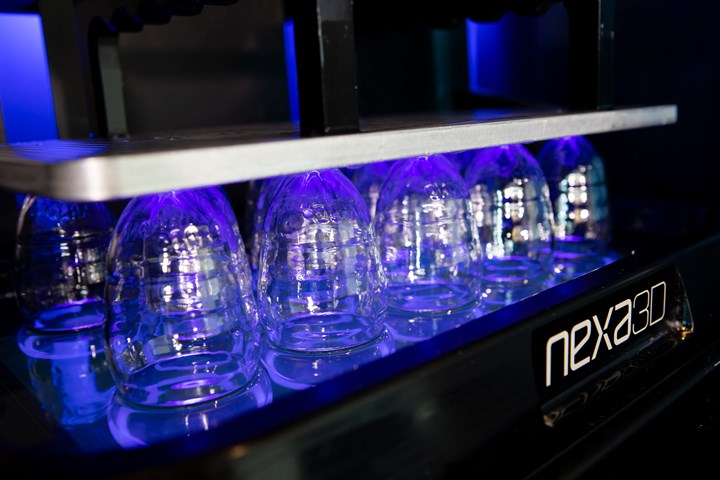
The ultrafast NXE 400 manufacturing process offers multiple possibilities for greater design agility, supply chain resiliency and ultrafast implementation at every phase of the product lifecycle. Combining Nexa3D’s productivity with Henkel’s rapidly expanding portfolio of functional polymers, makes it possible for customers to manufacture a wider range of parts such as housings, enclosures, pipes, packaging products, footwear components and production tooling for greater performance and functionality. The three photoplastic materials are:
▪ xPP405-Black is a tough semi-rigid material with high-strength engineering plastic delivering good impact resistance with performance similar to unfilled propylene. This photoplastic boasts a modulus like PP, an impressive 130% tensile elongation at failure, and excellent UV weathering stability as characterized by ASTM G154 testing. It reportedly delivers an attractive industrial black finish and is ideal for a wide variety of design, engineering and manufacturing of end use parts for piping, consumer and industrial applications, including large housings and enclosures and sheet metal forming dies.
▪ xPP405-Clear combines clarity, toughness and impact strength with good heat deflection temperature between 50 C /122 F to 60 C/140 F. This photoplastic boasts a modulus like PP, 130% tensile elongation at failure, and exceptional UV weathering stability as characterized by ASTM G154 testing. Grade xPP405-Clear can be finished for excellent clarity and is perfect for a wide range of design, engineering and manufacturing of end use parts including packaging, bottling, piping and see-through elements such as transparent materials for light guiding applications and micro-fluidics as well as lighting applications.
▪ xPEEK147-Black is a tough material with a good surface finish, and a strong dimensional stability featuring high-heat deflection temperature. Reportedly, it is an ideal material for production tooling, molding applications and a variety of functional end use parts including automotive underhood applications. This bioplastic exhibits higher temperature resistance of up to 230 C/446 F with very high stiffness and is shown to be thermally stable for long periods with good solvent resistance and dimensional stability.
Said Hankel’s head of innovation for 3D Printing Ken Kisner,“We are pleased to further expand our partnership with Nexa3D as Loctite’s portfolio of photo-plastic and photo-elastic materials are well-matched for the higher throughput of the NXE400 3D printer. The Nexa3D team have continued to deliver robust 3D printing solutions, and together we look forward to continuing to deliver an expanded portfolio of production tools, materials, and the validated workflows that the industry requires to realize the full potential of additive production.
Said Nexa3D COO Kevin McAlea, “We believe that our rapidly expanding collaboration with Henkel, now spanning six Loctite materials, coupled with our demonstrated productivity gains achieved by our ultrafast NXE400 3D printer and up to 85% lower total cost of ownership, delivers higher productivity, better extended life functionality and exceptional economics. Both companies are committed to democratizing access to scalable additive polymer solutions empowering customers to own their supply chain throughout their entire product life cycle from design to production and aftermarket success.”
Related Content
Business Slowing? There's Still Plenty of Stuff to Do
There are things you may have put off when you were occupied with shipping parts to customers. Maybe it’s time to put some of them on the front burner.
Read MoreMake Every Shot Count: Mold Simulation Maximizes Functional Parts From Printed Tooling
If a printed tool only has a finite number of shots in it, why waste any of them on process development?
Read More3D Printing of Injection Molds Flows in a New Direction
Hybrids of additive manufacturing and CNC machining can shorten tooling turnaround times.
Read MoreDaimler, OMIC Evaluate Wire-Fed DED for Moldmaking
3D printing a core and cavity on machine from Gefertec, followed by machining, allowed for a complete mold tool to be produced in three days.
Read MoreRead Next
Understanding Melting in Single-Screw Extruders
You can better visualize the melting process by “flipping” the observation point so that the barrel appears to be turning clockwise around a stationary screw.
Read MoreWhy (and What) You Need to Dry
Other than polyolefins, almost every other polymer exhibits some level of polarity and therefore can absorb a certain amount of moisture from the atmosphere. Here’s a look at some of these materials, and what needs to be done to dry them.
Read MoreAdvanced Recycling: Beyond Pyrolysis
Consumer-product brand owners increasingly see advanced chemical recycling as a necessary complement to mechanical recycling if they are to meet ambitious goals for a circular economy in the next decade. Dozens of technology providers are developing new technologies to overcome the limitations of existing pyrolysis methods and to commercialize various alternative approaches to chemical recycling of plastics.
Read More













.png;maxWidth=300;quality=90)




